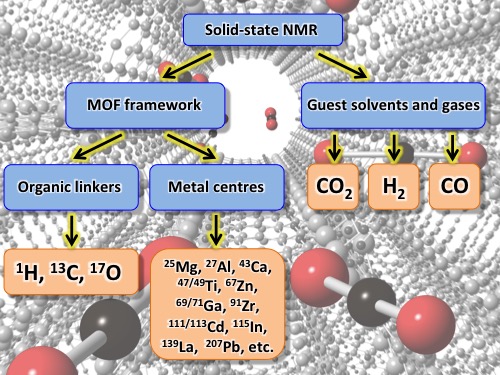
1. Characterization of Metal-Organic Frameworks via Solid-State NMR
Metal-organic frameworks (MOFs) are an emerging porous material. They are prepared via self-assembly of metal cations/clusters with organic linkers, giving rise to 3D networks with novel topologies. MOFs have high thermal stability, permanent porosity, and exceptionally high surface areas, leading to important applications in industrially-relevant fields. A major focus of study in our research group is the characterization of metal centers, linkers, and guest species in MOFs using solid-state nuclear magnetic resonance (SSNMR) and computational modeling. For example, the metal centers in MOFs typically play some role in guest binding, yet monitoring the local electronic and magnetic environment about such metal nuclei using SSNMR is not straightforward; these metals are typical challenging quadrupolar nuclei with unfavourable NMR properties. We have been characterizing MOFs using SSNMR of metal centres such as 47/49Ti, 67Zn, 91Zr, 25Mg, and 115In using our 400 MHz (9.4 T) and 600 MHz (14.1 T) instruments at UWO along with the powerful 1.5 MHz (35.2 T) NMR spectrometer at Maglab (https://nationalmaglab.org). We are also able to target specific nuclei within the organic linkers and guest species using SSNMR techniques in order to investigate their local structure and environment. The objective of this research is to understand the role of the metal centers, linkers, and guest species in processes such as catalysis and guest adsorption.

2. Post-synthetic Modification of MOFs
The robust structure and the ability to functionalize the organic component of MOFs allow one to introduce diverse chemical functionalities into MOFs through post-synthetic modification (PSM) while keeping the overall MOFs topologies intact. PSM has been widely used as a general approach to improve the existing, and introduce new properties to MOFs. We have been working towards establishing protocols for PSM targeting various applications, which include creating hierarchical pores in microporous MOFs, defect engineering, introducing non-framework cations in MOFs etc.

3. The Locations and Motions of Guest Molecules in Porous Frameworks
Adsorption of guest species into MOFs and zeolites is the first step for many important industrial applications; unfortunately, the connections between applications and guest adsorption, location, and dynamics are often unclear, and obtaining information on the latter items is experimentally difficult. Using SSNMR, vibrational spectroscopy, and computational chemistry, we are investigating the location, structure, and motion of guest molecules within porous materials, along with host-guest and guest-guest interactions. In particular, we are interested in ascertaining how important small molecules such as CO2, H2, C2H2 and CH4 interact with and move within these porous systems. We are also pursuing links between how nanoscopic behaviour, such as the precession of a guest gas molecule upon an adsorption site, may relate to macroscopic properties, including overall gas adsorption capacity. The long-term aim is to gain a fuller understanding of the guest behaviour within these porous materials, with an eye towards making better choices of host frameworks for important industrial and environmental applications in the future.

4. Crystallization of Microporous Materials
Adsorption of guest species into MOFs and zeolites is the first step for many Microporous materials such as zeolites, AlPO4-n and other molecular sieves are highly crystalline framework materials with regular pores, cavities and channels. They are widely used in industry as catalysts, ion-exchangers and sorbents. Understanding the formation of these materials is extremely important for designing new materials for specific applications. We are examining the crystallization of microporous materials under hydrothermal, ionothermal and dry-gel conversion conditions. Very recently, we have begun a new line of research, which is in-situ solid-state NMR study of the formation of molecular sieves. The ultimate goal is to enhance our ability to rationally design novel materials with desired properties for specific applications in the future.

5. Tuning the Properties of Microporous Materials by High External Pressures
In collaboration with Prof. Song at Western, we are examining the effect of high external pressure on the adsorptive properties of zeolites and the behavior of MOFs with different topologies, metal clusters and organic linkers under high pressure. These investigations involve the use of in-situ FT-IR and Raman spectroscopy, along with X-ray diffraction techniques. As pressure is increased, phenomena such as alterations in local structure, changes in local bond lengths, and new or altered guest adsorption sites can be observed; this knowledge has important applications in fields such as high-pressure gas storage. The overarching goal of this research is to tune the specific properties of novel porous materials under high external pressures, such as tailoring the adsorption behavior of the materials to yield size-selective adsorbents suitable for gas separation.